Look, Sarge, No Charts World War TWo





Tired of leading squads? Ready to command battalions?
Some Reviewer Comments
"An excellent set of rules fitting nicely into the battalion level niche... It produces bloody, decisive results and I feel this represents combat at this level better than the I go U go slugfests." Paul Timms, Journal of the Society of Twentiety Century Wargamers, issue 60, Winter 2007.
"All in all a really nice looking set, that seems to combine playability and realism to a high extent." Luc Burlage, Wargame Illustrated, number 233, March 2007
What makes Look, Sarge, No Charts: WWII so special?
Look, Sarge, No Charts: WWII is the first rule set to feature the Look, Sarge, No Charts(TM) rule system. Look, Sarge, No Charts: WWII (LSNC: WWII) features dynamic mechanics that allow the players to fight the battle, not the rules. Players command up to a battalion. In these rules reconnaissance is important, infantry matters, maneuvering large formations can be difficult, and "realism" is gained through simple mechanics that stress the players' decision making. Do not assume, however, that this means that Look, Sarge, No Charts: WWII is a bag-full-of-dice and "sixes hit" system. Five years have gone into the systems in this booklet. When you play Look, Sarge, No Charts: WWII, you will be challenged and excited.
... And best of all, there are no charts cards to detract from the fun, clutter the aesthetics of your table, or slow down the game.
Look, Sarge, No Charts: World War II has a number of unique innovations that together create an exciting experience for the long-time gamer as well as the younger novice. These include:
-
 Innovative "double" random card- and dice-based activation system that provides the drama and unpredictability of card-based activation while avoiding having everyone standing around watching one person at a time perform actions.
Innovative "double" random card- and dice-based activation system that provides the drama and unpredictability of card-based activation while avoiding having everyone standing around watching one person at a time perform actions. -
 Startlingly simple spotting system that is fast and realistic -- without the need for complex charts with stacks of modifiers.
Startlingly simple spotting system that is fast and realistic -- without the need for complex charts with stacks of modifiers. -
 Absolutely unique morale system. There is no morale phase, yet morale is important to the game. Results of morale failure are are quickly resolved.
Absolutely unique morale system. There is no morale phase, yet morale is important to the game. Results of morale failure are are quickly resolved. -
 Chartless combat resolution. Everything you need to conduct combat is on the labels on the backs of the bases. This takes into account weapon types, armor values, and defensive value of terrain without dozens of modifiers.
Chartless combat resolution. Everything you need to conduct combat is on the labels on the backs of the bases. This takes into account weapon types, armor values, and defensive value of terrain without dozens of modifiers.
The net result is a game that allows players to make the decisions appropriate to battalion commanders. Finally a battle doesn't feel like a skirmish! Battalion commanders don't worry about the orientation of tank turrets, what ammunition the tanks are firing, or who is manning the machineguns. In Look, Sarge, No Charts: WWII, players fight the battle, not the rules.
In the words of a devout player of another rule system, "this game really moves!" If you pass by a table on which Look, Sarge, No Charts: WWII is being played, and then come back an hour later, the table will look completely different. This is not one of those systems that looks and feels more like Crecy than Cobra. This is maneuver warfare, not attrition warfare. Good tactics are rewarded; bad tactics are punished.
Join us on our yahoo groups list. Optional rules, photos and battle reports, and scenarios are posted periodically. Questions are answered by the authors.
If you want a sheet of lables to print, fill in, and glue on your bases, click here.
If you want a sheet of labels to print and glue on cubes to make your special dice, click here.
Click here for a battle report of a LSNC: WWII game I wrote for Miniature Wargames magazine. This article includes a pretty good synopsis of the rules.
Click here for the article that Scott Fisher and I wrote about converting the Skirmish Campaigns scenario books for use with Look, Sarge, No Charts: WWII. This article, published in issue 233 of Wargames Illustrated magazine has a detailed overview of the mechanics of Look, Sarge, No Charts: WWII.

Russian tanks come over a rise and run into Germans in the woods. This scene is not "prettied up" for the picture. There are no chart cards to clutter the table and spoil the aesthetics of the figures and terrain you spend so much time creating. Everything you need to play Look, Sarge, No Charts: WWII is on the small labels on the backs of the bases and a few special dice.


In LSNC each base represents a platoon or headquarters. Players are meant to command battalions. In the rules, a platoon base is three-inches wide, but there is no need to rebase your figures if you don't want to do so. Many LSNC players (including one of the play testers) put two of their bases for some other game on a "sabot" base with the correct labels for LSNC. This works just fine.
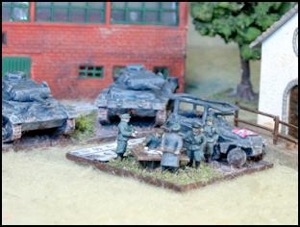

Here are three shots of Buck's France 1940 games at Cold Wars 2007 and one shot of Chris' Russian 1941 game. These tables and photos are not prettied up. This is what a Look, Sarge, No Charts: WWII game looks like in progress.
Here is the link to a nice after action report by Paul Timms of England of a game he and his son played using LSNC. Paul also posted a some pictures of 20mm figures based for Look, Sarge, No Charts: WWII on the Society of Twentieth Century Wargamers site. Finally, Paul did a very nice, illustrated battle report of a Look, Sarge, game he played. Jay Haygood wrote another fine battle report and review of the rules at this link.
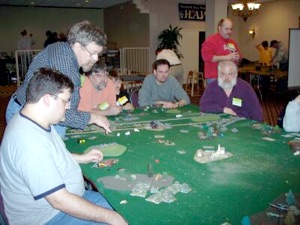



On 17 August 2009 the authors of Look, Sarge, No Charts: World War II were invited to officiate at an officer development session for an Army signal unit in Western Maryland. The purposes of the event were: exercise decision making and problem solving, expose young officers to simulation, and provide some team building through friendly competition.
Buck Surdu and Chris Palmer (authors of LSNC) along with Sam Fuson, the battalion S-1, and Ed Duffy (a local gamer) set up a 12-player Russian front game set around Troyanka. The Germans were trying to close off an encirclment while the Russians were trying to hold open the gap and extract their forces from the trap.
Most of the officers were junior officers, lieutenants and captains, with the battalion commander and her senior officers filling the command roles.
After spending about twenty minutes explaining the historical situation and the rules, the game began. None of the officers had played wargames before. (Most military simulations are arbitrated through sophisticated computer models hooked to real-world command and control devices, so young officers don't see the kinds of "manual" simulations we use in the hobby any more.) After two turns, the young officers were able to run the game themselves, with only occasional questions of the game masters.
LSNC allowed them to focus on tactics and trash talking across the table. The GM's have run hundreds of convention games, but it was very fun to watch the level of excitement and the good-natured insults slung across the table when each base was elminted from the game.
The officers really enjoyed the experience. Many expressed a desire to do it again, and some expressed interest in attend an HMGS convention. The battlaion commander said that all her objectives for the event were met and presented battalion coins to the game masters and event organizers.
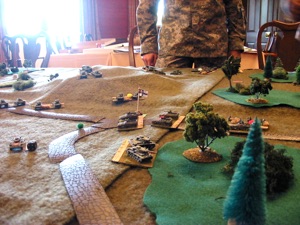
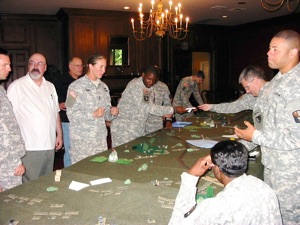

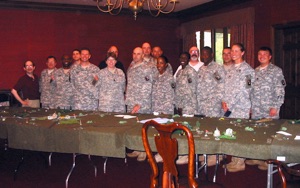
Troyanka, August 1941
Chris and I ran a large Look Sarge, No Charts: WWII Extravaganza, played on a 30 ft table with 12 players. The battle was a recreation of the engagement at Troyanka in southern Russia in August of 41. The battle was the final closing of the Uman pocket trapping large numbers of Russians.
Click here to get a copy of the Troyanka scenario Chris and Buck ran at Cold Wars 2008.
The Soviets started in the center of the battle with the objective of holding open a corridor to allow the trapped units an escape route. The Germans' (armor and mountain infantry) mission was to close this corridor. Victory points were awarded for control of points that define the size of the gap. At the end of each turn, each side gets victory points for each of the points on the ground they control.
The Russians started with two infantry battalions in the west facing three battalions of German mountain infantry. In the east the Russians had a motorized infantry battalion which was faced by two German panzer battalions and a panzer grenadier battalion. There was also a small German kampfgruppe which ha worked its way to a position just south of Troyanka. On turn two the Soviets received the following reinforcements coming south through Troyanka: two tank battalions and one motorized infantry battalions.
The Kampfgroup pushed into the woods near the town of Troyanka, from which the scenario gets its name, where its Panzergrenadiers held off Russian armor and infantry nearly the whole game. The Russians had real trouble unbunching their armor battalions and infantry. One of the Russian armor battalions was focusing on the Kampfgroup until it suddenly realized there was another German armored battalion coming on its flank. General Schlegle (player's name) did what we hoped would happen (for the first time in three times we tested and ran this scenario) and bypassed the Russian village (filled with Russian infantry) with his two armored battalions. One of those armored battalions was the one hitting the flank of the Russians. Unfortunately that's where the maneuver ended. The German armor commander, a young boy, focused on fighting the Russian tanks in some woods, when he should have fixed and bypassed them. Similarly the German armor on their other flank took a while to get past the town and didn't play a major role in reducing the Russian escape corridor.
On the 'infantry flank,' the German mountain troops did not push aggressively. They had one battalion that was placed to have easy access to one of the critical points on the ground, but they never went after it. The Germans ground the Russian infantry down, and the Russians were on the verge of collapse, but they never quite broke through. In the end, on points, it was a marginal Russian victory, but for most of the last half of the game, I thoght the big German breakthrough was imminent. On the whole, everyone seemed to have a good time, we got the maneuver and movement that Chris and I wanted (and that is so UNcharacteristic of games at this scale with other rules).
One of the high points for me personally was the convert we made. An Army buddy and his friend dragged an Army Colonel the work with in the Pentagon to the convention. He didn't want to play, but insisted on just watching the game. By the end of the game he had taken over command of a battalion and was maneuvering his forces. He had never played a wargame before. My buddy sent me an Email a couple days later with the words "You've created a convert!" in the subject line.
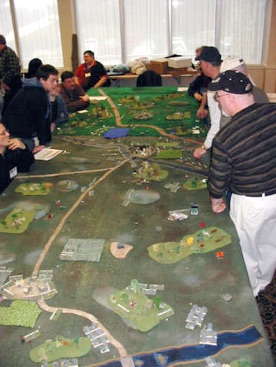
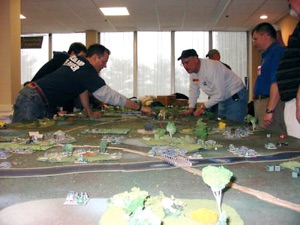
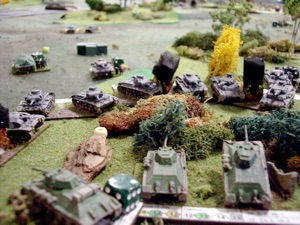
Read this review on Board Game Geek:
http://www.boardgamegeek.com/collection/items/boardgame/35703?comment=1


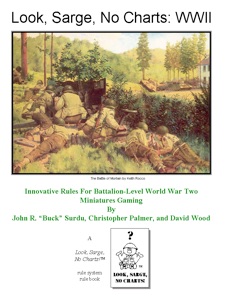
This is the set of rules that started it all. We didn’t set out to design a set of rules without chart cards. We were seeking a game of maneuver warfare in which units... well, maneuvered. We were tired of “operational” rules that plodded along, where two hours into a game, the table didn’t look much different than when you started. We wanted reconnaissance to matter and infantry to be more than speed bumps for tanks. During development, Buck developed and threw away three complete sets of rules, keeping some elements and throwing away many, many others. We are quite proud of the final result.
Join us on our yahoo groups list. Optional rules, photos and battle reports, and scenarios are posted periodically. Questions are answered by the authors.



For those misguided souls who just must have a chart, click here to download a unit roster for use with these rules.

Duncan Adams created a supplement for Look, Sarge, No Charts: WWII for early World War I. It is called The Slaughter So Swift, from a quote by Winston Churchill. You can download it for free here.

-
๏You can purchase a PDF version of LSNC: WWII at Wargames Vault at: http://www.wargamevault.com/product/192620/Look-Sarge-No-Charts-World-War-II?term=look+sarge%27&test_epoch=0
-
๏You can purchase a soft cover book from On Military Matters at: http://onmilitarymatters.com/pages/dfsearch.php?term=keywords&data=look+sarge&submit=Search
